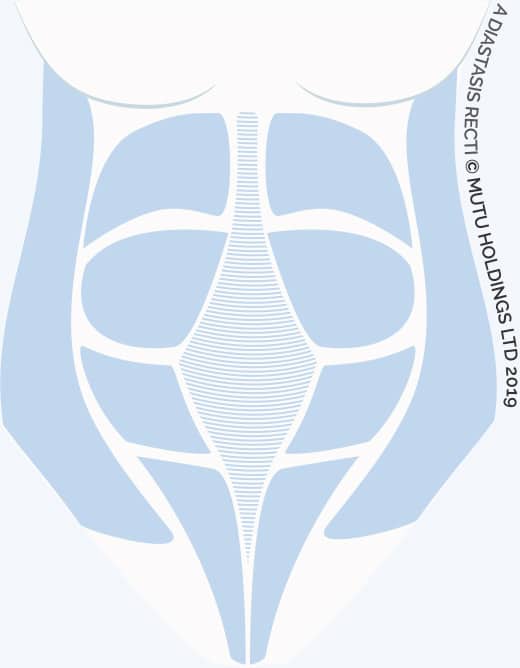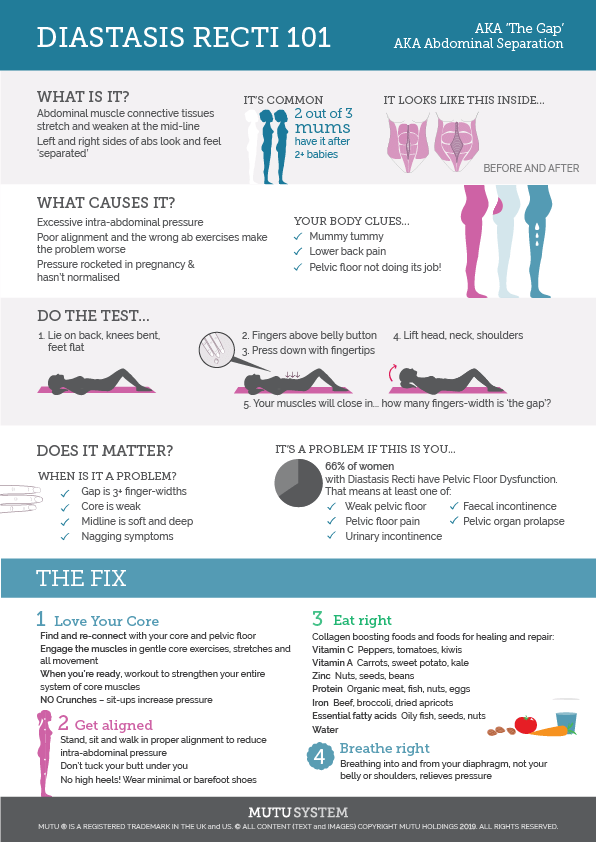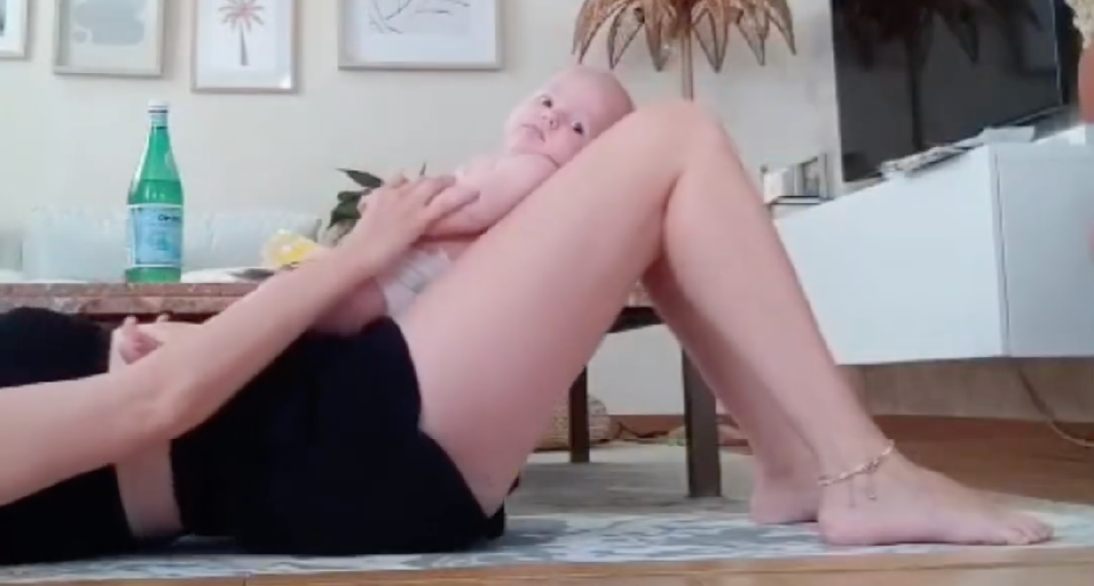
Our diastasis recti infographic gives you the lowdown on what you need to know about abdominal separation or DR.
Diastasis recti is the widening of the gap between the 2 sides of the Rectus Abdominis muscle. The split occurs at the Linea Alba, the mid-line collagen structures of connective tissue at the front of your abdomen.
AKA: DR, diastasis, ‘Divarication of the Recti’, DRA or ‘Rectus Divarication’.
Totally normal, very common and not ‘an injury’. You can have a perfectly functional core and still have a small gap.
Feel free to share our diastasis recti infographic (in its original form, credited, obvs 😉 )

MUTU is world recognised and medically proven in hospital-run trials as well as by tens of thousands of customers to heal diastasis. We’ve got you.









Hi Wendy! I have a 1 finger gap above my belly button and a 2 finger gap under my belly button. No bulge when I do the DR check anymore. But I’m still having really bad bloating, bulge above my belly button and the pregnant look when I eat anything! Is it possible I’m still having problems because I didn’t properly strengthen my abdomen and did not fix my DR even though I’m down to a one finger gap? And what is normal? Is there supposed to be no gap any where in your abdomen? FYI I am not on your program yet but will be soon 🙂
Hi Wendy,
You focus a lot on the Transverse Abdominal muscle and pelvic floor, but I find my ‘gap’ is larger 1-2 fingers above my belly button and 1 finger below at 6 months postpartum. I would assume you address those muscles as well in your program but does what i have constitute diastasis recti or am I being paranoid?
Hi Wendy,
You focus a lot on the Transverse Abdominal muscle and pelvic floor, but I find my ‘gap’ is larger 1-2 fingers above my belly button and 1 finger below at 6 months postpartum. I would assume you address those muscles as well in your program but does what i have constitute diastasis recti or am I being paranoid?
Hi, I am a Crossfit athlete and was wondering if I can do this program and continue crossfit? Thanks
Hi Lety, please see this post https://mutusystem.com/en-us/postpartum-exercise/how-long-postpartum-till-i-can-crossfit-plank-run/
Hi, I am a Crossfit athlete and was wondering if I can do this program and continue crossfit? Thanks
Hi Lety, please see this post https://mutusystem.com/en-us/postpartum-exercise/how-long-postpartum-till-i-can-crossfit-plank-run/
Hi Wendy,
I recently purchased the Focus program and am ecstatic to begin it. Quick question, when the exercise cheat sheet states x10, is that ten reps or ten seconds? I ask because in phase I, the first exercise asks you to hold and squeeze the ball for ten seconds only.
Thank you,
Raina
Please use the members group on Facebook or contact us directly – we have great resources for customers which will get a faster response than we’re able to offer on the blog! https://www.facebook.com/groups/MuTu.Mamas/
https://mutusystem.com/contact-mutusystem.html
Hi Wendy,
I recently purchased the Focus program and am ecstatic to begin it. Quick question, when the exercise cheat sheet states x10, is that ten reps or ten seconds? I ask because in phase I, the first exercise asks you to hold and squeeze the ball for ten seconds only.
Thank you,
Raina
Please use the members group on Facebook or contact us directly – we have great resources for customers which will get a faster response than we’re able to offer on the blog! https://www.facebook.com/groups/MuTu.Mamas/
https://mutusystem.com/contact-mutusystem.html
Hello Wendy, everybody,
I have a crucial question for me. First I am very happy to join this group and can’t wait to start! I purchased the 12 weeks program and will start asap but my question is : can I do elliptical??? this is my favorite machine and I have one at home (just legs no arms movements) and I want to know if I can use it as well?
Thank you!!
Hinda
Hi have you joined the closed Facebook group? That’s where customers can ask questions + get answers daily direct from our team! request to join here (email must match the one you purchased with. Any problems contact [email protected]) https://www.facebook.com/groups/MuTu.Mamas/
Hello Wendy, everybody,
I have a crucial question for me. First I am very happy to join this group and can’t wait to start! I purchased the 12 weeks program and will start asap but my question is : can I do elliptical??? this is my favorite machine and I have one at home (just legs no arms movements) and I want to know if I can use it as well?
Thank you!!
Hinda
Hi have you joined the closed Facebook group? That’s where customers can ask questions + get answers daily direct from our team! request to join here (email must match the one you purchased with. Any problems contact [email protected]) https://www.facebook.com/groups/MuTu.Mamas/
Hi. I had a child 6w ago. After the 1st week I was 10lbs lighter and after then 2nd week I was 3″ from prenatal waist measurements. I started working out at 4w after my grandparents came to visit me and they were feeding me all the time – I thought I was getting fat because my tummy was getting bigger. I started walking but the bulge kept getting bigger so I up’d up my workout routine. Everything I eat makes me gassy and uncomfortable. I can’t tell if I have this, or my I have a bulge from eating the wrong foods, or from working out!? It’s stressing me out because I have to make tape in a a couple months for my job. I have 4th degree and cervix lacerations which I ‘m still healing and were resewn so I can not to pelvic exercises for months. If I’m working out wrong, what other exercises can I do postpartum that are safe, because I’ve been researching it and all I hear is “do your pelvic floor exercises.
https://mutusystem.com/tummy-still-looks-pregnant-after-childbirth.html
I read this article, so that’s what I’m referring to when inquiring as to why my stomach is bloating.
Where’s the answer I can’t find it ?? I’m 6 weeks post partum and did lower Ann exercises 6 days a week since 2 weeks post partum with me first .. Now my stomach is bulging
Hi, I’m a 45 year old mom to almost 19 year old twins. That was my only pregnancy, thank goodness. 🙂 I was very thin before my pregnancy & gained over 60lbs/27kg, all of which was belly. My boys were 7lbs each.
I’m trying to determine which program would be best for me.
Thanks in advance!
I always suggest the 12 Week program unless there is a medical reason for you to avoid any intensive exercise Deanna.
Hi, I’m a 45 year old mom to almost 19 year old twins. That was my only pregnancy, thank goodness. 🙂 I was very thin before my pregnancy & gained over 60lbs/27kg, all of which was belly. My boys were 7lbs each.
I’m trying to determine which program would be best for me.
Thanks in advance!
I always suggest the 12 Week program unless there is a medical reason for you to avoid any intensive exercise Deanna.
hello! i had my son a year ago and I have noticed I have had a bulge after pregnancy. I started working out 4 months after and worked out for 3 months. then I stopped and started slouching and eating crappy food. here i am now and I look like I’m pregnant which I am not. what is happening to my body?
You just need to take care of your body Kristen, and it will respond! Our 12 Week Program is holistic and is perfect for you – it covers food, exercise, alignment, everything you need to feel good again!
hello! i had my son a year ago and I have noticed I have had a bulge after pregnancy. I started working out 4 months after and worked out for 3 months. then I stopped and started slouching and eating crappy food. here i am now and I look like I’m pregnant which I am not. what is happening to my body?
You just need to take care of your body Kristen, and it will respond! Our 12 Week Program is holistic and is perfect for you – it covers food, exercise, alignment, everything you need to feel good again!
Hi! It’s been 7 years since my last baby. Two sections. I have diastas rectify…but also a large hernia….about three inches above my belly button. Can I benefit from this program?
Please read this section Kristi https://mutusystem.com/hernia-and-diastasis-recti-postpartum-umbilical-hernia.html
Hi! It’s been 7 years since my last baby. Two sections. I have diastas rectify…but also a large hernia….about three inches above my belly button. Can I benefit from this program?
Please read this section Kristi https://mutusystem.com/hernia-and-diastasis-recti-postpartum-umbilical-hernia.html
Hello, I just gave birth 2 weeks ago. I would like to start this right now, is it gentle enough a program to begin now? I am anxious to begin exercising to feel healthier-2 weeks of laying around is getting to me.
Hello, I just gave birth 2 weeks ago. I would like to start this right now, is it gentle enough a program to begin now? I am anxious to begin exercising to feel healthier-2 weeks of laying around is getting to me.
Hi Sarah, yes you can start MuTu now. MuTu Focus is safe to follow, or if you opt for the 12 Week Program, delay the intensive workouts (they’re introduced in Week 3) until you are at least 6 weeks postpartum and have the all-clear from your doctor to exercise. But the core and alignment and walking work? Start as soon as you feel able!
Hello, I just gave birth 2 weeks ago. I would like to start this right now, is it gentle enough a program to begin now? I am anxious to begin exercising to feel healthier-2 weeks of laying around is getting to me.
Hi Sarah, yes you can start MuTu now. MuTu Focus is safe to follow, or if you opt for the 12 Week Program, delay the intensive workouts (they’re introduced in Week 3) until you are at least 6 weeks postpartum and have the all-clear from your doctor to exercise. But the core and alignment and walking work? Start as soon as you feel able!
Hi, my name is Marie. I have been struggling with my belly for years now. I like to think of myself as a fit person but I cannot lose that belly. I just recently started reading about diastasis and realized that could be what is wrong. I did the self test and the gap is about a finger wide when I lift my head but the belly rises when I do a crunch or lift my legs (to the point where it looks like I have a loaf of bread under my skin). The same think happens when I am standing up and leaning backwards, the loaf pops out. I have encl. a picture of my belly and my “loaf of bread in the oven”. I only have one child and he is 6 now so it’s a long time ago.
I recently did the 30-day plank challenge but realize that was not such a good idea. Should I just stop working my abs and focus on pelvic/back strength?
Thanks for your input.
Marie
Hi Marie, I have answered your question on the other post 🙂
Where’s the answer I can’t find it ?? I’m 6 weeks post partum and did lower Ann exercises 6 days a week since 2 weeks post partum with me first .. Now my stomach is bulging
Hi Marie. Could I ask what yr answer was? This is exactly me 🙂
Hi, my name is Marie. I have been struggling with my belly for years now. I like to think of myself as a fit person but I cannot lose that belly. I just recently started reading about diastasis and realized that could be what is wrong. I did the self test and the gap is about a finger wide when I lift my head but the belly rises when I do a crunch or lift my legs (to the point where it looks like I have a loaf of bread under my skin). The same think happens when I am standing up and leaning backwards, the loaf pops out. I have encl. a picture of my belly and my “loaf of bread in the oven”. I only have one child and he is 6 now so it’s a long time ago.
I recently did the 30-day plank challenge but realize that was not such a good idea. Should I just stop working my abs and focus on pelvic/back strength?
Thanks for your input.
Marie
Hi Marie, I have answered your question on the other post 🙂
Where’s the answer I can’t find it ?? I’m 6 weeks post partum and did lower Ann exercises 6 days a week since 2 weeks post partum with me first .. Now my stomach is bulging
Hi Marie. Could I ask what yr answer was? This is exactly me 🙂
Hi Wendy, I t have DR I’m a 48 yr old mom of 4, my baby is 16,do you think you can help me? And if so where do I start?
Sign up for the free information in the pink cloud at the top of the page, You’ll get a free report to explain a lot more. Check out our programs here https://mutusystem.com/download-the-mutu-system-coaching-programme.html, as well as expert medical comment + customers testimonials (all under ‘Results’ in the menu options at the top). And welcome 🙂
Hi Wendy, I t have DR I’m a 48 yr old mom of 4, my baby is 16,do you think you can help me? And if so where do I start?
Sign up for the free information in the pink cloud at the top of the page, You’ll get a free report to explain a lot more. Check out our programs here https://mutusystem.com/download-the-mutu-system-coaching-programme.html, as well as expert medical comment + customers testimonials (all under ‘Results’ in the menu options at the top). And welcome 🙂
Hello Wendy, I currently am suffering from a diastasis recti and prolapse. Also, I am 15 weeks pregnant. I was wondering if there was anything I could do to fix these problems now as I don’t want them to get worse?
The MuTu Focus Program is likely to be safe + beneficial for you but should only be carried out with your Doctor’s approval. More info here https://mutusystem.com/mutu-focus-program-online.html
Hello Wendy, I currently am suffering from a diastasis recti and prolapse. Also, I am 15 weeks pregnant. I was wondering if there was anything I could do to fix these problems now as I don’t want them to get worse?
The MuTu Focus Program is likely to be safe + beneficial for you but should only be carried out with your Doctor’s approval. More info here https://mutusystem.com/mutu-focus-program-online.html
hello Wendy,here is a quick question, is MUTU just for mothers? I am not married nor am i a mother,but i have always had a flat tummy,but as i get older ,my tummy is getting bigger, can MUTU be used by me as well. Al
Sure! It’s about alignment + restoring core strength. The program is made for mothers, but the content will benefit anyone in need of core help! Please remember that belly fat is a food + hormone issue, not a muscular one… Our 12 Week program tackles all of this, but is generally focused on the postpartum body.
hello Wendy,here is a quick question, is MUTU just for mothers? I am not married nor am i a mother,but i have always had a flat tummy,but as i get older ,my tummy is getting bigger, can MUTU be used by me as well. Al
Sure! It’s about alignment + restoring core strength. The program is made for mothers, but the content will benefit anyone in need of core help! Please remember that belly fat is a food + hormone issue, not a muscular one… Our 12 Week program tackles all of this, but is generally focused on the postpartum body.
Hi Wendy, I recently purchased your MUTU Focus DVD. I have a 16 week old baby. This is my third baby and I have an umbilical hernia and and Diastasis Recti. I have been in phase one for 6 days. I am already feeling a difference. Thank you. I have a question on breathing. I am not sure if I am breathing correctly. How do you breath into and from your diaphragm?
Hi lee + welcome! The easiest place to ask questions once you’ve started one of our programs is the closed Facebook group – we can give you much more detailed help than I am able to here. Do you gave access? If not, please email my Team (click ‘contact’ – far right at the top of the page) + they’ll let you in!
Hi Wendy, I recently purchased your MUTU Focus DVD. I have a 16 week old baby. This is my third baby and I have an umbilical hernia and and Diastasis Recti. I have been in phase one for 6 days. I am already feeling a difference. Thank you. I have a question on breathing. I am not sure if I am breathing correctly. How do you breath into and from your diaphragm?
Hi lee + welcome! The easiest place to ask questions once you’ve started one of our programs is the closed Facebook group – we can give you much more detailed help than I am able to here. Do you gave access? If not, please email my Team (click ‘contact’ – far right at the top of the page) + they’ll let you in!
Thank you!! It’s beau-tee-fil!
Thankyou! X
Thank you!! It’s beau-tee-fil!
Thankyou! X